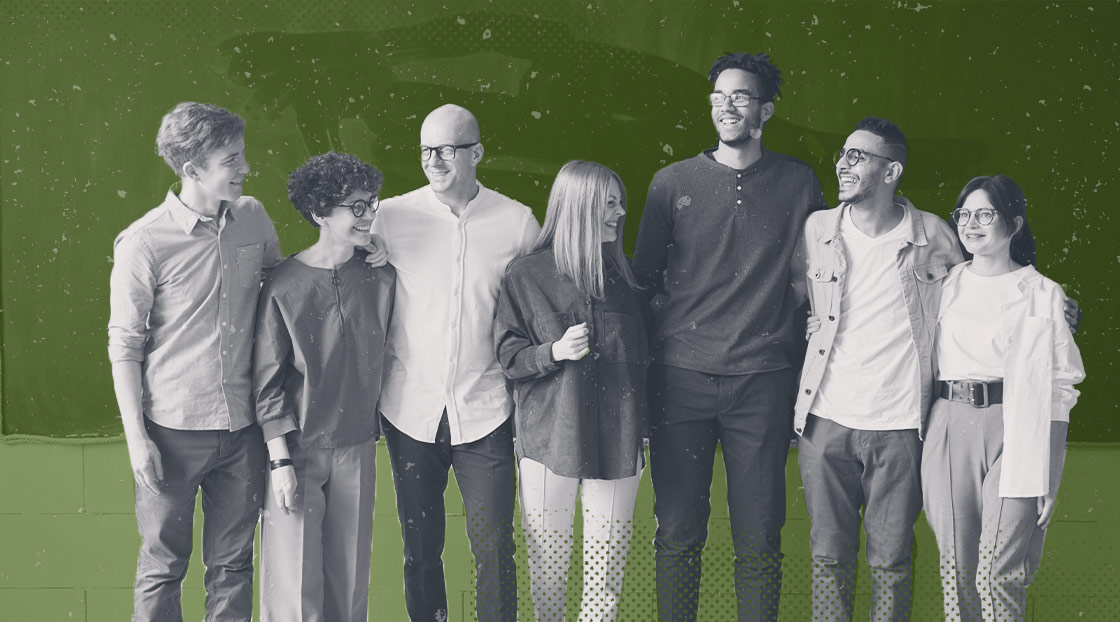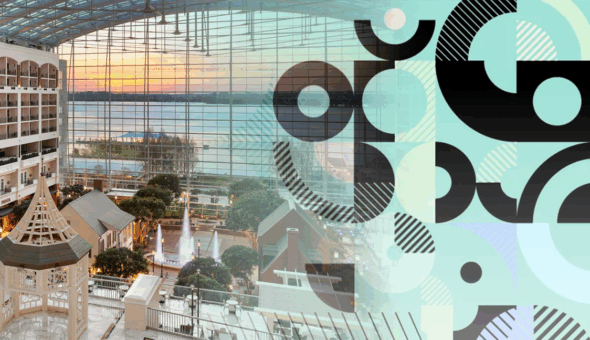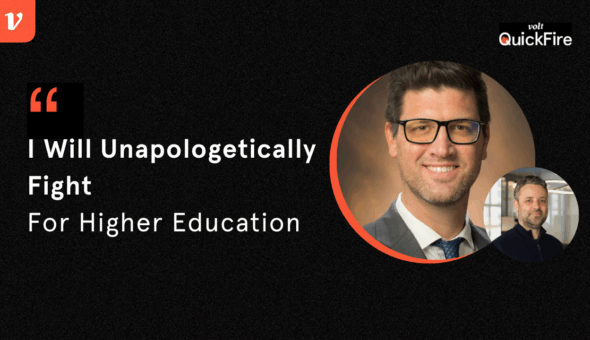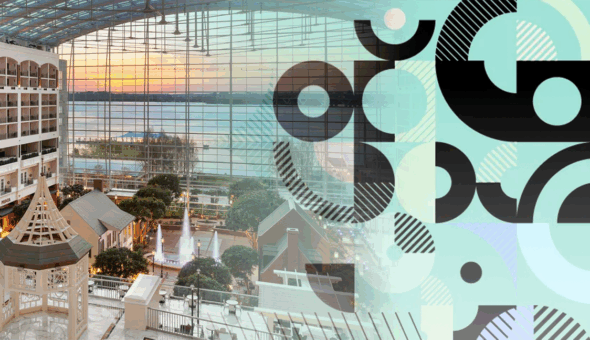Diversity, equity, and inclusion initiatives are major efforts at colleges and universities, not to mention key parts of marketing efforts. But are those efforts as genuine as they sound in brochures and social media posts?
In the latest Higher Voltage, host Kevin Tyler is joined by Jaime Hunt, vice president and chief communications and marketing officer at Miami University, and Ayana Hernandez, associate vice chancellor for university relations at North Carolina Central University, to discuss the opportunities and obstacles institutions face when it comes to ensuring their inclusive marketing is delivering.
- An overview of Jamie’s recent article, “Inclusive Marketing, Front and Center” (3:21)
- The importance of including DEI initiatives in an institution’s brand guidelines (6:07)
- How are campuses living up to their promises that their inclusive marketing is delivering (16:44)
- The obstacles higher ed faces in solving DEI related issues on campus (30:11)
- Leadership’s concerns of drop in ranking as their inclusive marketing efforts evolve (36:32)
- Lessons learned through the process of evolving your inclusive marketing efforts (45:22)
References and additional readings:
- University of North Dakota’s Diversity and Inclusion Guidelines
- The California State System’s Diversity/Inclusivity Style Guide
- University of Dayton’s Brand Guide: Diversity and Inclusion Best Practices for Marketing and Communications
Read the full transcript here:
Kevin Tyler:
Hello, and welcome to Higher Voltage, a podcast about higher education that explores what’s working, what’s not, and what needs to change in higher ed marketing and administration. I’m your host, Kevin Tyler.
Kevin Tyler:
Welcome back to Higher Voltage. Today’s episode is Inclusive Marketing Front and Center and joining me today is Jamie Hunt from Miami University of Ohio and Ayana Hernandez from North Carolina Central University. I’m very excited to chat with both of you about a topic that is near and dear to my heart. I’m excited to learn about what’s going on at your institutions and how the two of you plan on evolving marketing to be more inclusive, not just for your institutions, but also for the industry.
Kevin Tyler:
I think it’ll be a great conversation. Before we dive in, I’d love to have each of you introduce yourselves briefly. Talk to me about just briefly how long you’ve been at your institution, what some of the things you are responsible for, and then we’ll dive into our conversation. So Jamie, let’s start with you.
Jamie:
Sure. So, thank you. I’m so excited to be here, Kevin, and to meet you in person and to see Ayana again. I’m Jamie hunt. I’m the vice president and chief marketing officer at Miami University, the one in Ohio, not University of Miami in Southern Florida. I’ve been here for about 18 months and I have enjoyed every minute of it.
Jamie:
I am responsible for all marketing and branding at Miami. I have a team. When we’re fully staffed, we’ll be about 66 and we’re responsible for institutional marketing and branding as well as the individual colleges, we have a centralized model and then I’m also responsible for admission marketing. So, it’s a pretty big portfolio, but it’s a great institution with great partners across campus.
Kevin Tyler:
Awesome. Thanks Jamie. Ayana?
Ayana:
Yes. Well, thank you so much for hosting this conversation, which I think is a very important one and one that I hope your listeners will take away some nuggets from. So, Ayana Hernandez, I serve as associate vice chancellor for communications and marketing here at North Carolina Century University in Durham. And I have been here for 10 years, 10 years in January, and the areas my office is responsible for include all of the communications, media relations, public relations, social media for the institution. Definitely work in strong collaboration with other areas on campus, like our web services department.
Ayana:
But we’re generally responsible for just all of the institutional reputation management programs, and definitely work in collaboration with our colleges and schools and admissions office as well as institutional advancement. And my team is much, much smaller than Jamie’s, but I am definitely really proud of the work that we are able to do on behalf of our students and our faculty and our staff. So, thank you again.
Kevin Tyler:
Thank you very much for that. All right. So, I was reading an article that you wrote, Jamie, recently called Inclusive Marketing Front and Center. And that’s really the impetus of our conversation here today, because I wanted to follow, ask you a bunch of questions about that piece. Can you talk to me a little bit about what you wrote about and what the impetus of that article was?
Jamie:
Yeah. So, when I started, it was September 2020, and my team had been struggling with how the university responded to the George Floyd murder, and they really felt like they wanted to play a part in the change and in leading that change and I think in the marketing communications offices, we’re the front door, we’re the face, we’re what people see. And so we really have an obligation to be front and center around DEI issues.
Jamie:
And they knew that I was coming from an HBCU, and that have been involved in DEI work since I started in higher ed in 2004. They were really excited for me to help them get to that place. And so one of the very first things that we did was create a DEI value statement for our department that talks about addressing our biases and acknowledging our privilege and actively working to eradicate what we could, but recognizing that it’s a journey and that there’s not really an endpoint in the journey and you just have to be open to the evolution of yourself and your thinking.
Jamie:
And then when we were working on our brand guide, the director of brand strategy, and I really wanted to have this be front and center for communicators. We really wanted this to be something that people do not think of as a check box, that they think of it in a really authentic way and then it’s just in the fabric of who we are.
Jamie:
And so we decided it’s actually the first page after the table of contents to put this statement in there that talks about, it’s not a check box, it’s authentic stories. It’s accurate representation. And it’s about making sure that we’re going beyond that. Does this have check … the United Colors of Bennington, approach where it’s like, “Okay, we’ve got every kind of person in this ad.”
Jamie:
And really instead thinking with a lot greater intentionality from the start of a project and how we can incorporate it in. And we are really, really trying to help the rest of the campus communicators embrace that approach so that this isn’t just something that’s coming from the central office, but that the whole institution is embracing this and moving forward in this way.
Kevin Tyler:
I thought it was such an exciting term events to read that article. I work at an agency and I work with brand guidelines all of the time for higher ed institutions. And I have not seen one that included language around DEI, equity, belonging, that sort of thing. And as I was reading it and realizing how rarely I had seen that, it felt like it was such a shame that it felt so new to me at a time when it shouldn’t feel so new. And so I’m curious from both of you, why do you think it feels so new to include information around DEI in an official type document, like brand guidelines and higher education?
Ayana:
Well, I think for me, in just working and representing a historically black college or university and being also a product of an HBCU and knowing that from the founding of this institution, when we looked at why we exist and why we came into being was … It was a time when, in particular, from a racial perspective, African Americans were not admitted to schools in this area.
Ayana:
And so when you think back upon a time when you could not apply or be admitted and for our institution, we’re now in our 111th year, the fact that yes, we’ve grown, but we were always a center of opportunity. We never rejected anyone. And so when I think about diversity, equity, and inclusion, and I think about our institution in particular, and the fact that we are a welcoming campus because of the fact that why would we reject anyone when we know the hurt and the callous that has caused and that pain that exists in our country from our history?
Ayana:
And so when I think of DEI from a marketing perspective and the way I always look at it is, yes, we are in HBCU, but we’re so inclusive of so many different … And HBCUs in themselves are not all the same. We’ve definitely grown to diversify ourselves.
Ayana:
So, when I look at our marketing, I am always very intentional about ensuring that when we talk about who we are, that we are including the populations that we welcome to our campus. This is not anything that we’re we say we want to do. This is who we are. And I think another big point about that is that when we get further into this conversation, when we think about just first generation students who may not be exposed the diversity of experiences from that perspective, but we also want to make sure that we’re welcoming to our faculty and staff who also come from diverse backgrounds. And so, how do we ensure not only the language that we use, but the actions that we take? As Jamie mentioned, it’s part of the thinking of the institution and how we are again, intentional and committed to this. Not only in what we say, but what we do.
Kevin Tyler:
That’s great. I love that. Jamie, do you have any thoughts on that? Like why it feels so new now?
Jamie:
Yeah, I think it’s sad that it feels new, but also a little bit unsurprising. I can recall at an institution prior to working at WSSU, I was asked, “Why do you have so many black people photographed and profiled on the homepage?” And it was like, because they’re part of our student population. What are you talking about? It was a Southern institution that still had a lot of growing that it needed to be doing, and I think it has.
Jamie:
But it shouldn’t be new. It absolutely shouldn’t be new. But I think that for a lot of institutions, George Floyd’s murder was a line in the sand that they had to either cross or get knocked down. And I think that those schools that already had a commitment to DEI were ahead of the curve a little bit from other PWIs in terms of being able to jump on an anti-racist approach versus just a more neutral DEI approach. And I hope that we see more schools take that on and more schools have more of a holistic look at diversity, equity, and inclusion going forward.
Ayana:
And to just piggyback on that just a little bit, I think a big part of this is having those honest conversations and listening to what our students are saying, listening to what our faculty and staff are saying and the institutions that probably missed the mark haven’t been listening to perhaps concerns that students have been raising.
Ayana:
If they don’t feel welcome and if you’ve made this brand promise to them that when you step into our doors, we will have all of this, you will be supported, and then when they get there and their experiences don’t match up to that, that’s a fail. And that is where I think some institutions have not, again, really listened to and really had a pulse of and on the individuals that make up their campus community.
Ayana:
It’s like that Black history month, but it’s Black history 365 days a year and it’s not just pride week, but it’s really knowing how this should be part of your campus and your campus’s ethos.
Kevin Tyler:
Oh my gosh, Ayana, you just touched on, it’s like you’re walking around inside my brain. A lot of the points that you just made, we are going to talk about today, but also things I’ve mentioned before around heritage months and how we celebrate each other on campus and recognize accomplishments.
Kevin Tyler:
I want to follow a thread that actually both of you mentioned. It seems like so often the statements we hear from institutions around DEI, belonging, inclusion come after a horrific event. And I’m wondering why it feels like there isn’t more proactive communication around inclusion and DEI and belonging on campuses because it’s the right thing, as opposed to a response you something terrible happening.
Jamie:
That is a really good question. I think that at Miami, we do have a weekly communication that goes out to our entire campus community that talks about these issues, that has information about upcoming learning opportunities and things like that. And then, the president talks about DEI, he’s super passionate about it. Incredibly passionate about it and has made a lot of investments in that area. And every single talk he gives, he works conversation around that, into those talks.
Jamie:
I think back to when I was at WSSU and George Floyd was killed and my chancellor was Black. Students wanted him to say something and he was like, “I obviously don’t like this. Why do I have to say something? It’s obvious.” And the first thing we did was actually have our campus police chief send something to the campus about, this is not a reflection of how he will police and then actually had a communication come from all the police chiefs.
Jamie:
So, all the universities in Winston-Salem and the Winston-Salem and the sheriff put out a message that this is not representative of how we want to police and this is unacceptable to us and we will not behave in this way. We denounce this act.
Jamie:
But he still had to say something. So, I think some of those terrible times, people need reassurance from the leadership that they care and that they’re aware and that they’re listening and that they’re hearing, but it absolutely can’t be that’s the only time that you hear from the leadership on that. You need to be hearing that everywhere you go, and there’s never enough.
Jamie:
There’s no cap on how much you can talk about it. So, work that in to everything. It’s just part of the pillars of who you are. And if that’s the case, if it’s truly part of who you are and who we believe the institution is, it shouldn’t be relegated to one office that communicates about it. It needs to be across the institution and it has to be in the hearts of everybody at the leadership table.
Ayana:
But I do think, again, higher education, we are the ones that often spur change. And so we are the ones that can do that and so we should do more of that. It’s our responsibility. It’s our responsibility to host those conversations in our communities. And many times, especially with HBCUs, we are part of the community. And so we don’t have gates here at NCCU.
Ayana:
So we host those conversations, not only with our internal community, but with the community that surrounds us because we want to make sure our students know. Also you’ve had the privilege to get to the point of coming to a higher institution of higher education. And so what responsibility do you bear in taking that forward? From a DEI perspective when you “make it,” and when you have the opportunity to bring others behind you, how can you make sure that you’re comfortable in the spaces and some of the spaces that our students step into after graduation, they’re the only one.
Ayana:
And this is 2022. They’re the only one. And so how make sure that you’re comfortable, that you can speak up, and that you can advocate for not only yourselves, but for others who have like experiences? Again, whether you are a person of color, whether or not you identify being part of the LGBT community, whether you’re the first in your family to go to college, this is all very new to you.
Kevin Tyler:
It’s such [inaudible 00:16:15] those topics that like, I’m the same way. I have so much to say about it because it’s so personal, but it’s also so professional. And in my work, what I try to do in the marketing efforts that I have with my clients is to ask questions that help them think about new ways to do things that feel more inclusive, because we are coming upon a time when people are going to look different coming into your school. And so are you prepared to have these conversations or not? And what you say in your marketing, what I do for a living, is going to lay out a set of promises.
Kevin Tyler:
But that’s what brings me to my next question is, and it was something that you mentioned earlier, Ayana, as institutions look to, as your have, looked to evolve their marketing into a more inclusive space, how is the campus itself evolving as well to meet or deliver against the promises that you’re more inclusive marketing is going to deliver?
Ayana:
As we talk about evolving, we talk here about, “Okay, we’re bringing in more Latino students.” Okay. What support services do we have to support that population? Not only to recruit them, but to make sure that they are part of our community? And so we started, not we, we university started a Hispanic Student Organization, [inaudible 00:17:35]. We also were the first HBCU campus to have a chapter of Lambda Pi Pi, which is a Latina sorority.
Ayana:
And so again, I say you’ll be welcome to here. I say you’ll develop as a scholar, as an innovator. You’ll be a change agent once you leave here. But in the classroom, but as equally as I support you in the classroom, I need to provide you with those support services outside of that.
Ayana:
NCCU, I would say when we stepped out in being the first HBCU in North Carolina to have a staffed LGBTA center, because those conversations in our communities are sometimes a little bit difficult. But we said, we need to make sure we support our students in that space.
Ayana:
It’s not only just having a center and having safe zone training for faculty and staff in making sure that our pride [inaudible 00:18:37] pops here, but also when we talk about homecoming, we have a drag show. A full on drag show during homecoming. We’ve done it for three years and it’s one of the most popular events during our homecoming. And so again, it is making sure that you have those support services in place.
Ayana:
We also know from just making sure that we’re supporting our students from other aspects of, when we say diversity and inclusion, we have a Muslim student association that we started. We have an Asian American student, an Asian student association that we started. So again, having those … Not just saying that we’re going to promise you you’ll see your face in our collaterals and our materials. Because I think it’s really important, as Jamie said, we use the students who, we don’t hire talents. We do not hire talent. There are plenty of faces and stories, rich stories, and rich legacies that we can showcase here on our campus.
Ayana:
And so, again, it’s providing that support and from our faculty and staff perspective, we make sure that we have that support there too, because our student is changing, our demographic is changing. How are we making sure that our faculty and our staff community, that they have the resources they need to ensure the students that are entering their classrooms, or entering their residence halls, or entering their offices, that they provide them with what they need to be successful.
Kevin Tyler:
Let’s take a quick break to talk about our sponsor. Higher Voltage is brought to you by Squiz. University websites are filled with great information, but oftentimes a simple internal site search does not give users the information they’re looking for. Funnelback, the site search product by Squiz, changes the way people engage with content by revolutionizing search. It delivers relevant and comprehensive search results for users, which is key for business objectives. Visit squiz.net, that’s squiz.net, to see how Funnelback by Squiz can create a smarter site search option for your institution’s website today.
Kevin Tyler:
Jamie, what do you think? How is Miami university of Ohio evolving its campus to live up to the promises that you’re more inclusive marketing is delivering?
Jamie:
Yeah, so we have a actual multicultural marketing initiative happening where we’re thinking about how we need to talk to students where they are, meet them where they are, make sure that we using language that resonates with different demographic populations. But before we did that, we created a multicultural marketing group that has representatives that work in those student facing offices, faculty who work closely with BIPOC students, LGBTQ students, different directors from across campus that lead those resource centers and met with them to say, “What can we say that’s accurate? How can we make our marketing actually reflective of what a student’s going to experience here?”
Jamie:
And we spent a good, almost a full year, engaging in that before we started to actually work on a campaign. So, we want to make sure that we’re delivering on what we promise and we know that we’re not there yet in some areas and those areas, through these conversations, are now queued in. Like, yeah, we need to make sure that we can offer these more fully and more broadly. But I think that it’s irresponsible as marketers to market something without making sure it’s going to be an authentic experience.
Jamie:
And so I was so pleased. The multicultural marketing group was the brainchild of my senior director of marketing. So, I’m not going to take credit for Christian Pounce’s work. He’s brilliant. But he was 100% right that that’s what we needed to do. We also brought in speakers once a month to come in and talk to our full staff about just different cultural experiences.
Jamie:
So, we’ve brought in members of the LatinX community, we’ve brought in black students, we’ve brought in people who fall at the intersection of different identities, LGBTQ. And then that layered on top of the way President Crawford pushes DEI and pushes every vice president and every director to keep that in the forefront.
Jamie:
I think those things have come together to work towards a better experience. So, I don’t think I would be alone in saying that there is no end to this journey and that we have people on our campuses, particularly at PWIs, who are on a broad spectrum of understanding what privilege is, understanding biases, unconscious biases, all of that.
Jamie:
And so as evolved, as many people may be on this, there will always be people who are new to this journey and we have to give them a little bit of grace while we move them along. But we can’t let them drag us back. So, we have to keep moving people forward. But as marketers, we can’t say you’re going to have X experience on our campus and then not deliver it.
Jamie:
What was the moment for me that I knew Miami was going to work for me because I loved working at an HBCU absolutely loved it. I got on my soapbox about this. They said, “How would you recruit more diverse students?” And I went on a rant about, “We could not just bring people in and then tell them this and then they get that, and this is terrible.”
Jamie:
And I was like, well, either I got the job and it’s a place that I want to be, or I didn’t get the job and it’s not a place I want to be. But I could tell from the nodding heads around the screen that people were like, “Yeah, we just needed somebody to articulate that so that we could jump in from a marketing perspective and address it from that point.”
Jamie:
And so it’s a very supportive campus. I do feel sorry for people who work on campuses that haven’t embraced this as fully and are trying to market and are just given the directive, “Give us more diverse students.” And are not the interior work to make that happen.
Jamie:
I feel sorry for those marketers. And I’m happy to talk to anybody about the approach that I’ve taken leading my team. And I think as a white person, I have an obligation to be as loud as I can about it. And one other thing I’ll add, and this is personal and you might cut it out. But one other thing I’d add is that I am a queer woman who has been in the closet for 43 years and Miami University was the first place that I felt comfortable in my entire life to come out. And that speaks, I think, highly to the culture that President Crawford’s trying to create.
Kevin Tyler:
I think this is absolutely fascinating, and thank you for sharing the personal side of your story. I think that when you find a place you can be your whole, complete self and it’s a workplace, then you’re able to do far more productive work. I truly believe that 100%. I feel very strongly about that.
Ayana:
Can I mention two things that Jamie mentioned that I think are really important? First is listening. To be, I won’t say to be good, but to be successful in any DEI space, as well as other spaces, you have to listen. You have to be open to listening. Number two, you have to be very authentic. And I think three, which is Jamie, what you ended with is we as marketers and communicators need to be invested, we need to be passionate, we need to be committed to this work.
Ayana:
And so, if we’re the ones that are responsible for showcasing these pieces and these superlatives and the greatness of our institutions, we have to be invested and passionate about that. And we need to be the ones that are in those spaces, listening just as hard and many of us are already at the table.
Ayana:
But for those communications and marketing professionals that aren’t, just making sure that we are out there, we’re supporting these events that our students are having, we’re attending these lectures that are opening us up into spaces that we may not have known about before. I think those are really important points that Jamie mentioned to emphasize.
Kevin Tyler:
I think that’s really important. Both of those things. I mention this book all the time on this show, it’s called Just Mercy by a guy named Brian Stevenson. And in it, he talks about getting proximate. And I think the closer that you can be to things that are different than you, the more you can A, understand it, B, communicate about it and C, empathize with it in a way that will inform and improve what you’re doing in your day job and I feel strongly about that too.
Kevin Tyler:
One of the things I want to be clear on here is, and when we talk about inclusive market marketing, we were talking about the full spectrum of inclusion and diversity, and equity. I have legitimately been on campuses in years past working with clients where I saw their view book and they had the checklist of different kinds of people and one was in a wheelchair and I got to campus and it was hilly and there were no accessible ramps.
Kevin Tyler:
And those are the kinds of things that people look for in marketing. And so it’s just an interesting conversation to have when I enter a new engagement with a client and they say, “We want to recruit more diverse students.” There is a series of follow up questions I have to that, that I feel are necessary to ask. Like who and why, what the benefit is, what support systems are going to be here for when they arrive?
Kevin Tyler:
Those are the kinds of questions that I think we owe ourselves and the industry to ask as the populations of classes are going to change and more institutions are going to want to have that stat, and I hate to use like that, like we have a diverse campus. And that includes faculty, staff, students, the whole gamut. And so then we talk about this inside higher ed piece that came out a couple of weeks ago, and I’m going to read the quote that’s in it and it was a survey of a bunch of college presidents.
Kevin Tyler:
I think it was like 300 or 400 presidents that graded themselves on a whole list of different metrics on their campus. And one of them around race. And this is a direct quote from inside higher ed:
Kevin Tyler:
“And in a finding that each year befuddles many observers, presidents continue to perceive race relations on their own campuses as being either excellent 10%, or good, 63%. While barely a quarters say race relations are good on college campuses nationally.”
Kevin Tyler:
I think about this thing that happens in the art world and museums, where museums are less likely to share when a piece of art has been stolen, because they are afraid that other people will not donate their pieces of art to that museum. And I think about that as an analogy to this conversation around DEI and inclusion and belonging.
Kevin Tyler:
Of course, presidents are going to say that the race relations on their campuses are great or good because they want more people to come to their campus. But the truth looks like, and the news that we see, that it could be not the greatest or in fact not the goodest. And so, to what do we owe this rosy picture that we have about race relations on campus and inclusion and marketing and why marketing has done the way that it is? Even though in the face of it, we have all these headlines that say otherwise?
Jamie:
As an executive, I know that the people I hang out with all day, the people I’m in meetings with, are other executives. And most of them look like me. And I think that’s a big piece of it. The presidents across the country are largely white and they’re largely men. Obviously that’s changing and that needs to change, but it’s still the reality. Is that they’re largely white men. And if they’re spending their days only with other executives, they’re spending their days largely with white people and probably largely white men specifically.
Jamie:
And I think that gives you a sheltered view of what’s actually happening on your campus. I bet if you asked all the VPs for student affairs, you’d probably get a different answer. If you met with all of the DEI offices, you would probably get a starkly different answer. And so I think it’s more a function of who you surround yourself with.
Jamie:
And then this sort of, like you’re saying, you’re trying to sell people to come here. You don’t want to tell them, “Yeah, it’s going to suck. You’re going to hate it here, but we want you here anyway.” That’s not a good sales pitch. So, I think there’s some of that naivete and I think it takes a lot … I don’t know, I’m probably going to get hate mail. But I think it takes a lot for a white person to really see what’s happening. And it takes a lot, I think, for a white person to be a safe space where people feel comfortable telling them what’s happening.
Jamie:
You have to have your eyes open all time and you have to look and see and be watching and I don’t know that everybody does that, and I’m not saying these presidents are guilty of willfully ignoring, maybe some are. But I think that they’re probably not consciously putting on their glasses and saying, “Lift up the rug. What is under there? Let’s run our hands across the door frames and see what’s up there because our house ain’t clean and we need to know where it’s not and what we can do to fix it.” Does that make sense?
Kevin Tyler:
I think so. It makes sense to me. I think there is a distinct role for leadership, especially when it comes to that idea of getting proximate. I think that there’s a lot of space that can be created, whether good or for bad, created between a leader and the issue that’s happening on campus. That just ensconces them in a space that’s away from it. But the closer that you get with it, again, then you understand it and you can make decisions with that in mind, as opposed to just creating a task force and building a binder that will never see the light of day. Ayana, do you have any thoughts on that?
Ayana:
Yeah. So, I saw this question and I jotted down the fact that leaders have to be part of their campus. They have to get out. They have to engage with the students. They have to go to the faculty meetings because they’re passionate. Those faculty meetings are real passionate sometimes. They have to go to the staff senate meetings.
Ayana:
My chancellor here has been very good about making sure that he listens. We have our monthly, like many campuses, monthly meeting with our student leadership. We want to hear what’s going on. Give it to us. Give it to us in an unfiltered manner, because that helps us be better for not only you, but for the students who will come behind you.
Ayana:
I also think that it’s very, very important to recognize that there is still a lot of work to do. No matter where we are. On all our campuses. We still have a lot of work to do and the investment of resources to be able to do that work and being able to … We talk a lot in our spaces about measuring our success and how do you measure when you it’s actually making inroads and you’re being successful?
Ayana:
Well, if we know that there’s a lot of work to do, let’s also put some resources behind it to get the work done. And leadership making that investment says a whole lot. Last year, it was July. I think it was last July. We had a two day workshop that was actually sponsored by our Department of Diversity and Inclusion as well as our Career Placement Office that was titled, “So you want to recruit at an HBCU.” Again, after there was a awakening that HBCUs were fabulous and had produced all these alumni, are educating all these students for hundreds of years, we wanted to ensure that we have honest conversations with employers that were, some of them new coming to us about, “How do we really recruit from your campus, recruit your students, who are your students?”
Ayana:
And it was two days, it was virtual. I hopped in a lot of the sessions and we had executives from, we’re in [inaudible 00:35:29] research triangle park area. So, RTI International, Lenovo, and had them listen. And this helps them. And we got some really great feedback, from what I understand, from the team that put it together. Just saying, “This is really helpful for us to know.”
Ayana:
Not only as we are recruiting from your campuses, but recruiting from other campuses and recruiting from campuses that have makeups, maybe like ours, maybe not like ours.
Ayana:
But again, it goes back to listening and wanting to learn and wanting to do better. I think we all want to do better and so in the DEI space, how can we do better? Those conversations are never ending. But it’s first recognizing, you know what? We’re not excellent. We’ve got some work to do, even if it’s 10%, even if it’s 50%, we’ve got some work to do.
Kevin Tyler:
Yeah. I have just got a couple more questions for both of you. One of them is as you continue to evolve your inclusive marketing efforts, are you or your leadership or your institution concerned with any sort of drop in ranking? Unfortunately, accessibility and inclusion can sometimes be equated to lower quality for whatever reason. I’ll never understand that. Rankings is a conversation that every institution has. I have very distinct feelings about rankings and they’re not good feelings. But when we think about bringing in more diverse classes, are rankings part of this conversation in your-
Ayana:
I’ll just quickly answer this and I’ll pass it on to my colleague, Jamie. No. This is what we have to do. This is absolutely what we have to do. There is actually an alumnus of NCCU that works Chapel Hill, UNC Chapel Hill, and has done a lot of work around the changing demographic of our country.
Ayana:
If we look at just the data, and again, I’m just dealing with just racial demographics. We are changing. We are growing. And so don’t you want that stellar student who happens to be a person of color? Don’t you want that stellar student who just happens to be the first in their family to go to college? Don’t you want to attract them to your institution? And think about who they can then in turn recruit to come your institution. And so I’ll just say, no, we have to. It’s our obligation. It’s our obligation. So, I’ll turn it over to Jamie.
Jamie:
I have not once been in a conversation where we’ve talked about this as being something that would negatively impact the rankings. And you’re about to get me riled up here, so I apologize in advance. But I think that the idea that greater diversity would somehow harm the student profile is very deficit based thinking.
Jamie:
It’s like thinking that if somebody comes from a different cultural or ethnic background, that’s a deficit that they bring to your campus instead of a strength that provides something to the campus community that you need. And so I think when you think about … Miami is a selective school. We’re not an access institution. We do have our regional campuses, which are open access, but we’re a selective institution and we attract the very high caliber students. And there are just as many high caliber students in every possible race, ethnicities, gender, all of those things. None of those external factors to a person impact their ability to succeed at Miami based on their intelligence and their academic success.
Jamie:
And so at the end of the day, talking about that, the deficit based thinking has to go, and I feel like it has. At least at the institutions that I’ve been at lately, but other places maybe aren’t evolved like that yet. But I feel like we’ve stopped talking about it as low income or urban students. Lumping people into these monolith groups that have nothing to do with their ability to succeed.
Jamie:
Yes, there are historical challenges that people of color face in education that limit their opportunities and hold people back from being successful, but it’s not inherent to them. It’s external factors that have made that so. You’re getting me riled up.
Kevin Tyler:
Good.
Jamie:
We have an obligation to do what we can to remove those external factors as institutions of higher education so that people can be who they were meant to be and can thrive the way they were meant to thrive. And I’m getting on a soapbox.
Kevin Tyler:
Rankings be damned.
Ayana:
And Jamie, from that, what obligation do we then have, as I look at our school of education, to ensure we are producing teachers that look like the students who may come from backgrounds and communities that are tier one, tier two and might have some challenges. So, what obligation do we have as institutions of higher education in putting together programs that will then support us changing the economic trajectory of the communities in which the students that were educating are going back and impacting?
Ayana:
And so, I think that’s a big part of this as well. We have a juvenile justice Institute. We were looking at the number of young people who are being arrested at higher rates. What is it that we can put in place? What are the solutions and the conversations and the actions that we can put in place because of our influence as institutions of higher learning, to be able to make these changes, these very critical and necessary changes in our community so the “playing field” is a little bit more equal. I think that’s very, very important as well.
Kevin Tyler:
Yeah. I agree with you on that. And then on the outcome side of that, like what you were speaking of, I think there’s a really stark opportunity to start to diversify the outcome stories that we see in these marketing materials, right? And so often it’s 85 per percent go to Fortune 500 companies. If I’m in the 15% that doesn’t want to go to work out a Fortune 500 company, then where are the success stories that I want to see? Where are the teachers? Where are the people who are working in the park system? Where are the people who are artists? Who might not be making bank, they’re not making millions of dollars, but they’re happy, and that is more valuable to some people like me.
Kevin Tyler:
And so the way that we talk about who we want here, how we do things, and what you’re able to do. That all has space for more inclusive stuff to be shoved into it.
Kevin Tyler:
And it isn’t just about we welcome Brown, Black, gay, differently abled, whatever it is. That’s part of the conversation. It’s not the entirety of the conversation. And that’s why I think that this conversation around admissions and enrollment cannot be disconnected from retention. If you’re inviting people in and you’re not giving them what they need, you have a retention problem. But if you do invite them in and you do give them what they need, then you don’t.
Kevin Tyler:
And with this whole [inaudible 00:43:15] thing and all these new rules and all this stuff, everything’s up for grabs. Everything’s on the table. And so if you’re not serving the students and your faculty and your staff the way that they deserve and expect to be treated, they will go somewhere else because they’re able to.
Ayana:
I will say that I think in general, just because there are so many options these days for are talented, bright, young people. Their filter and the way that they are determining whether or not they will come to you and why they will come to you if you’re offering, and I think every institution is different, but why they might decide to come to you and not another institution might boil down to, I believe that I will be comfortable there, I believe that I will be welcome there, I believe that I will be supported there. Again, not just inside the classroom, but also outside the classroom. And I think what HBCUs do a really good job at in talking about this DEI conversation also is how passionate our alumni are.
Ayana:
If you run into an alumna, alumnus of many of our institutions, they are your greatest advocates. They will make sure that they bring the students. They will make sure, and we’re encouraging to give back as well. And so when we get to these tables, we’re going back to being the first in these spaces. We can make sure that we’re not the first, but we’re just opening up another door for so many others who will follow behind us, thinking about our alumni are really an important part of this conversation as well.
Kevin Tyler:
I always like to ask our guests what advice they might have for other institutions who are either looking to do this or in the middle of doing this, or thinking about doing this, have done this. What are some things that you’ve learned through these processes of evolving your marketing into a more inclusive space that you might be able to share with other folks who are listening?
Jamie:
So, from my perspective, and I say this so many times that I think people roll their eyes at this point, but bring more voices to the table. Get people involved in this process that you might not have thought of otherwise bring people in to have conversations.
Jamie:
I think some of the most rewarding conversations that we’ve had is when we’ve brought in people to just talk to the group about their experiences and what they find and discover at Miami. I think that it’s also important to proceed with intentionality and deliberateness. And so don’t just slap together some statement on DEI, or copy and steal, take Miami’s, change a few words, and then slap it in. It needs to be authentic to you and to your institution and it needs to have that intentionality to what you’re saying that is followed up by action.
Jamie:
You can’t just put this message in your brand guide and then say, “I’ve done everything I can for DEI.” It has to be followed up by action. And so to do that, to just jump in and slap something in there would be disrespectful to the process, and you’re not going to get as good of a result, and it’s not going to be authentic or beneficial to your institution or the constituencies we serve.
Kevin Tyler:
Amen on that.
Ayana:
And I think that there are really easy ways that we can ensure that when we say we have a commitment to DEI, we as the ones, the individuals that are doing that marketing, can attest to that. And when I say that campuses and higher education provide you those opportunities to get out and explore in ways that perhaps working in a corporate structure may not, it’s going to have the former director of our LGBTA center invite me to their lavender graduation that we have every year.
Ayana:
And as busy as we all are. I said, I need to be there. Number one, I was asked to go. Number two, I need to show up and just engage. And so I think that goes back to ensuring and helping to know that your messaging is authentic because it’s like, “Oh, yes, I’ve seen this for myself. I know that this is happening.”
Ayana:
It’s also getting into the corners and I think as Jamie said, making sure that there are several different voices at the table. But maybe going to that corner of your campus or your organization where those uncomfortable conversations are being held, or those very honest, transparent conversations are being held and it’s not being judgmental.
Ayana:
It’s really doing a whole lot of listening and learning and acknowledging that what I’m learning and what I heard, how can I take this back to someone else who can perhaps use this to make a change in maybe an organizational policy or structure or program to make it better? And so I think all of that is very important to just making sure that our DEI marketing communications is done well.
Ayana:
And I’m also just, I’m very nosy. I like looking and seeing what other folks are doing, and don’t be afraid to reach out. I’d say, in our community of marketers and communicators, we are a very open sharing group of individuals. And so if there’s something that I’ve learned, I’m more than willing to share it, as Jamie says. And she’s talking about the multicultural communications group, and I probably didn’t say it right, but that she’s put together, that’s an awesome idea.
Ayana:
So, I’d say if you reach out to Jamie, we’re here to help one another do what we’re doing on our respective campuses even better for the population of students, faculty, and staff that we’re serving.
Kevin Tyler:
I’ve had so much fun talking to the both of you. In closing, I’d love to say that one of the most exciting parts about what you wrote about, Jamie, and how you’re in infusing these conversations in formal documents like brand guidelines, is that it spreads the responsibility of accountability throughout the entire team and not just with the people in the marginalized audiences, right?
Kevin Tyler:
So, oftentimes I might catch something in something that’s like, “Oh man, they didn’t have anyone who looked like me on this committee and that’s why this looks like this.” But when you have it cemented or documented in the ways that you do in these formal ways, it makes it all of our jobs. And I think that’s the part that I think is missing on a lot of campuses. So I just want to say thank you for starting this conversation. There are really great examples that people can go look at at University of South Dakota. The UC system has a great example of inclusive brand guidelines, obviously in Miami of Ohio. But it’s a conversation that’s worth having on your campus as populations evolve and we’ll have a link to your piece on our episode page, Jamie, and I just want to say thank you both Ayana and Jamie for joining me today. I think this was a really great conversation.
Jamie:
Thank you so much.
Ayana:
Thank you so much.
Kevin Tyler:
That’s it for this week’s episode of Higher Voltage. We’ll be back soon with a new episode and until then, you can find us on Twitter at Volt Higher Ed, and you can find me, Kevin Tyler, on Twitter @KevinCTyler2.









